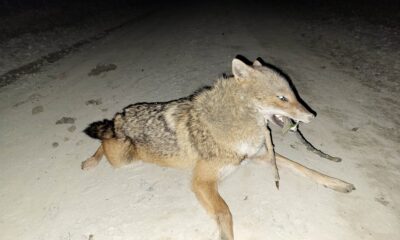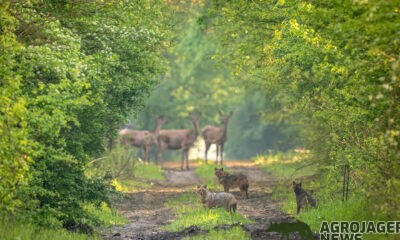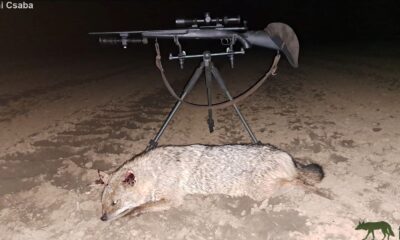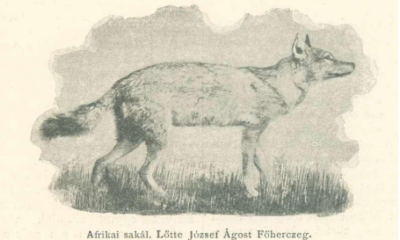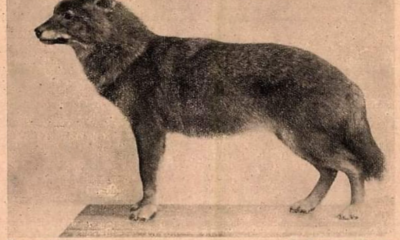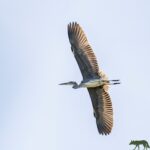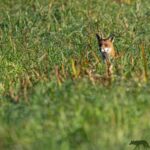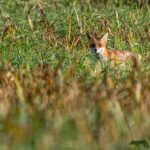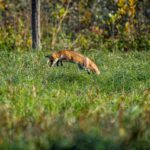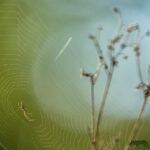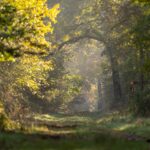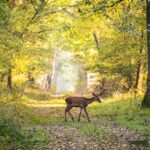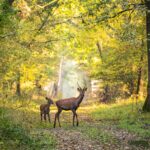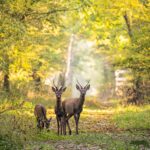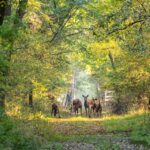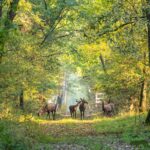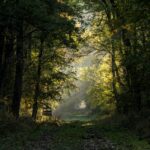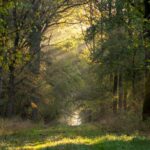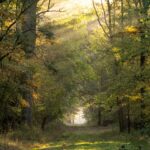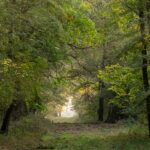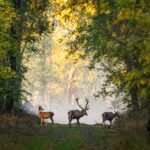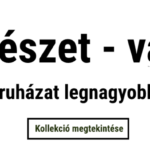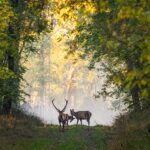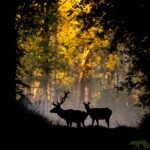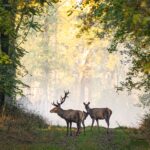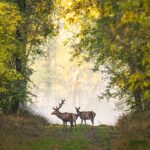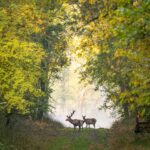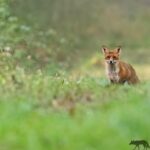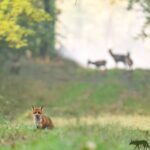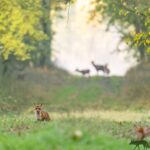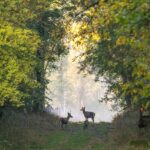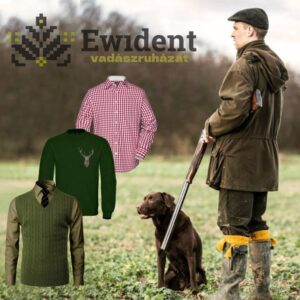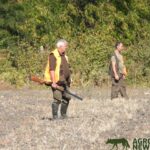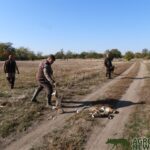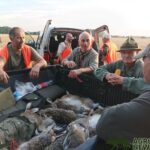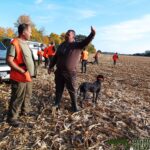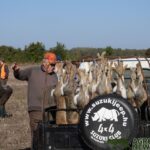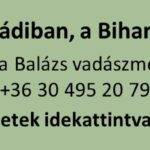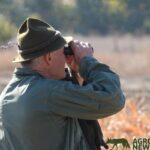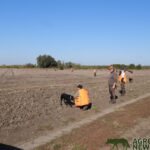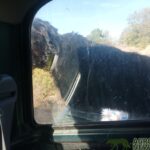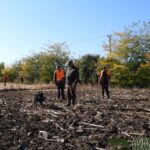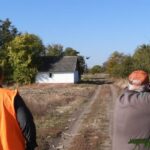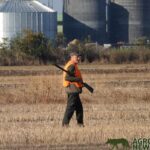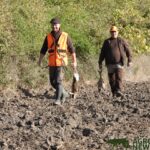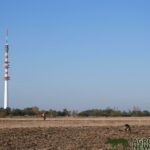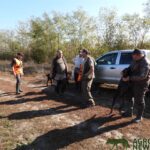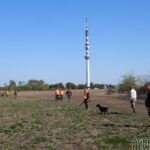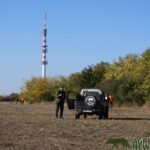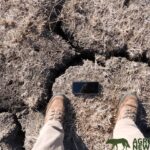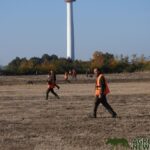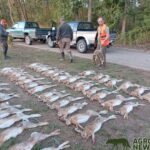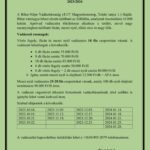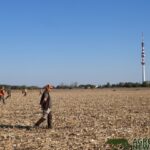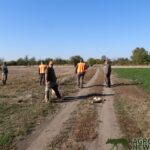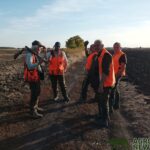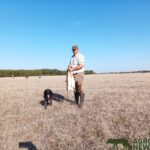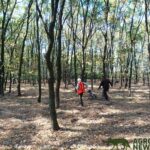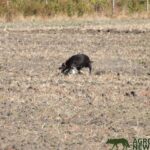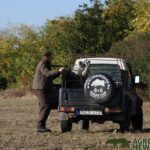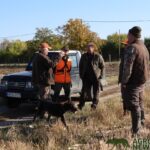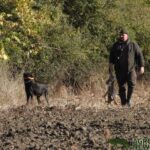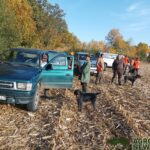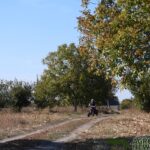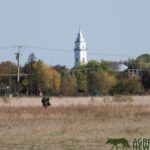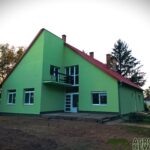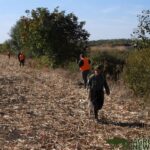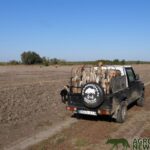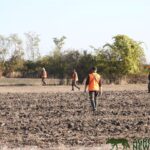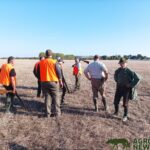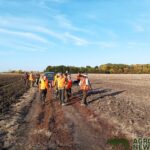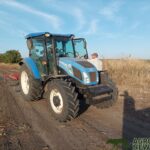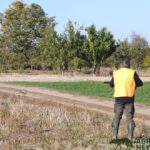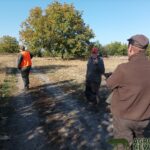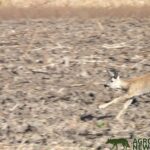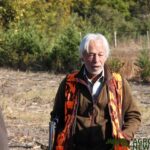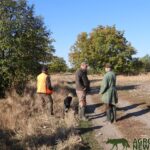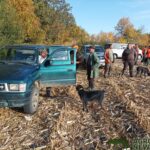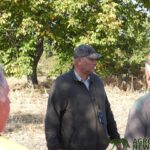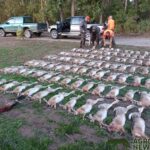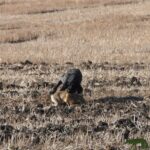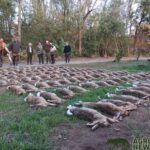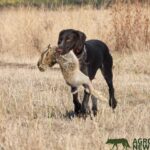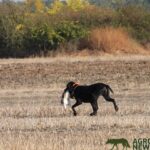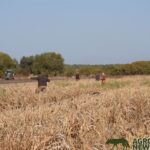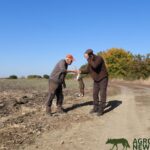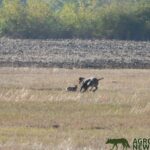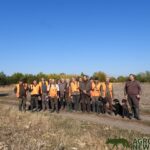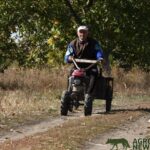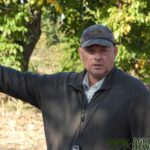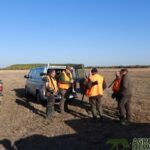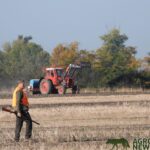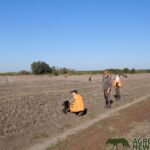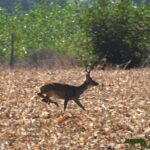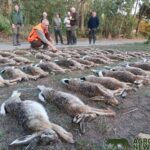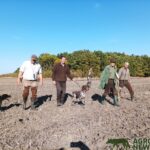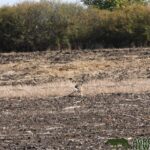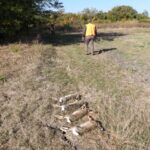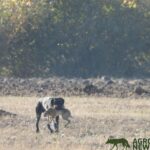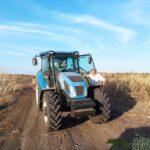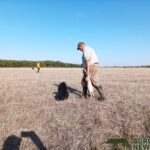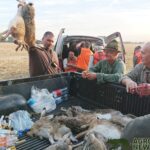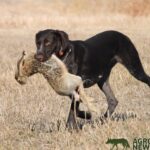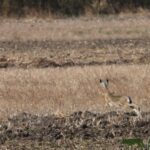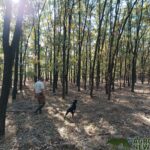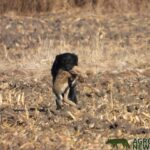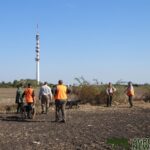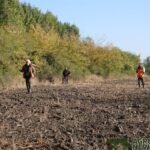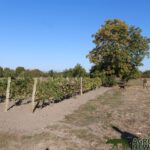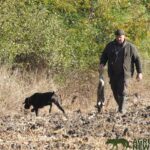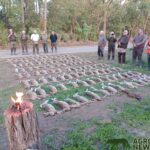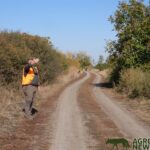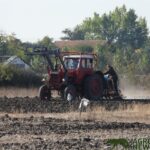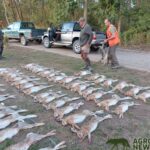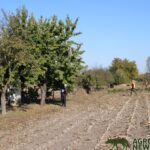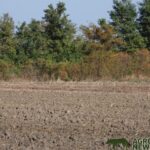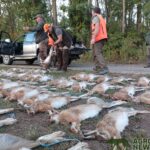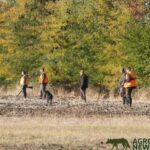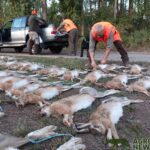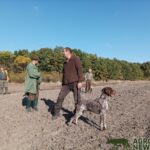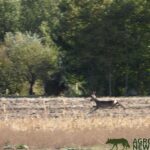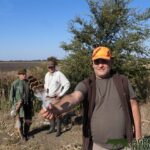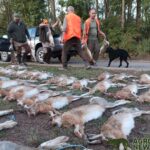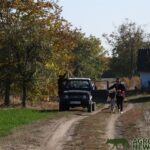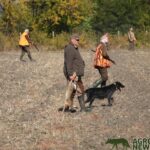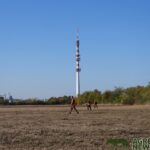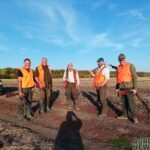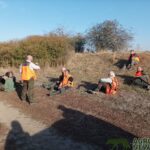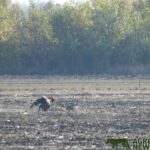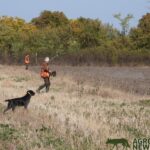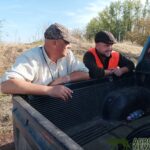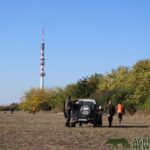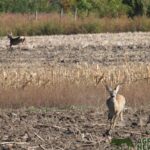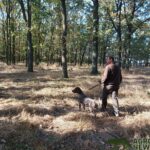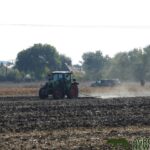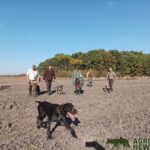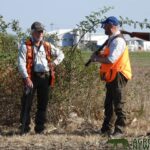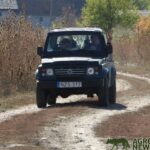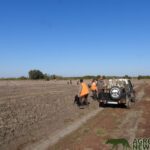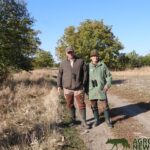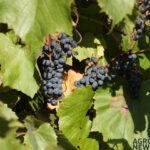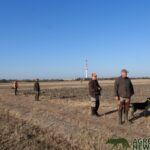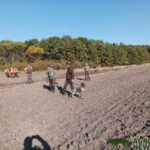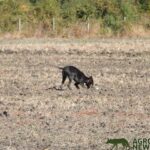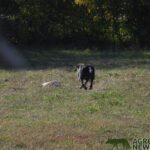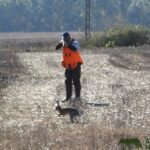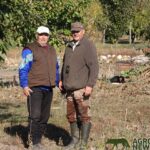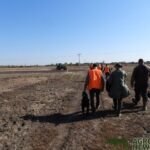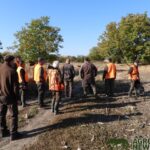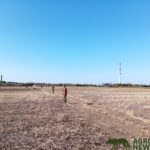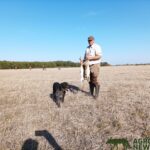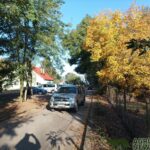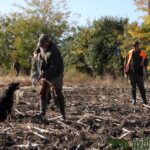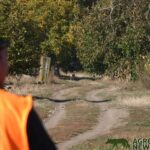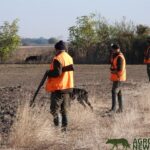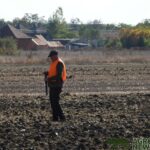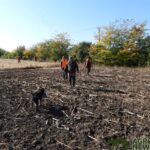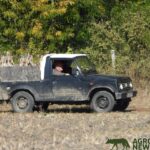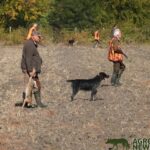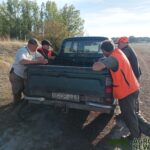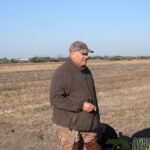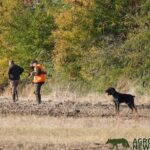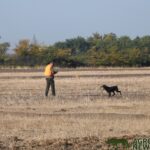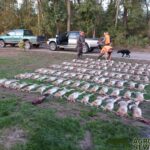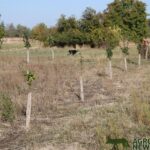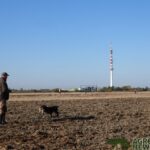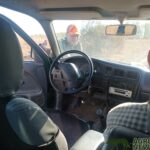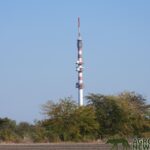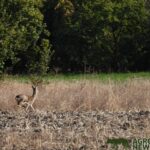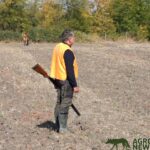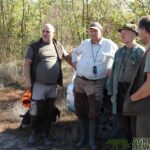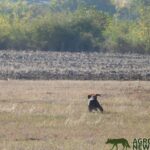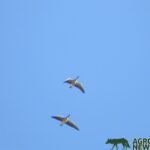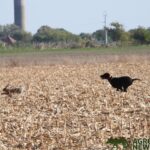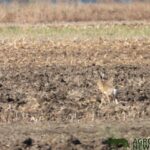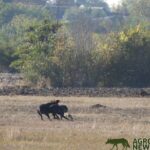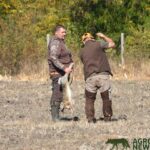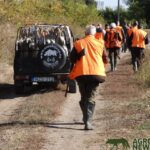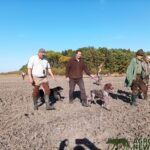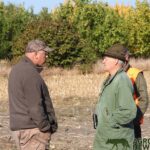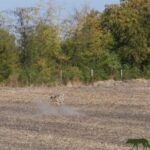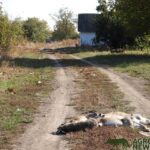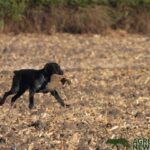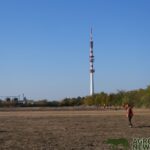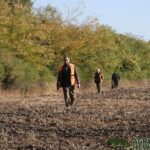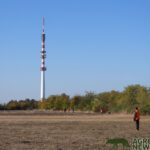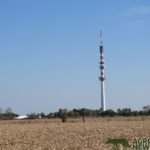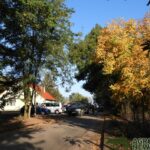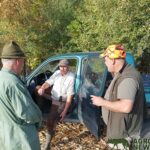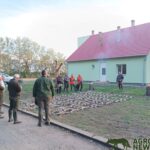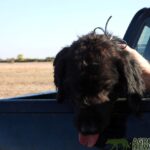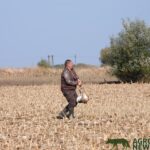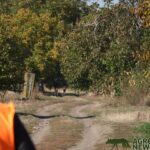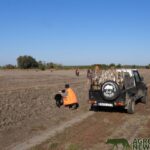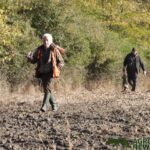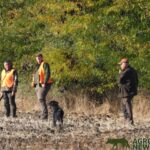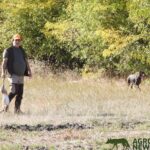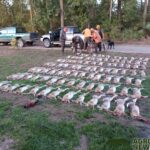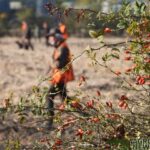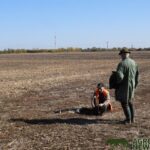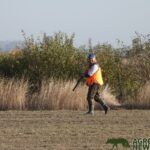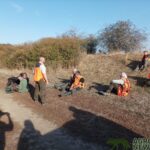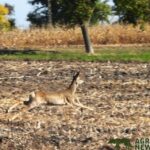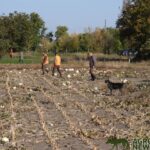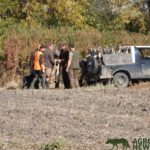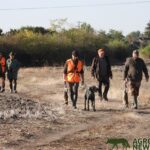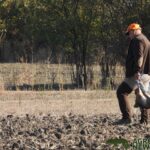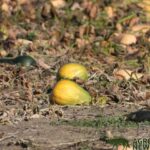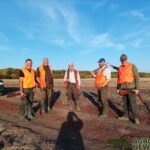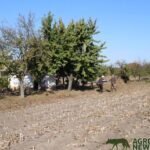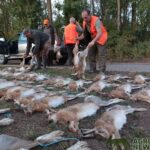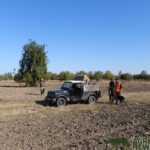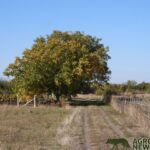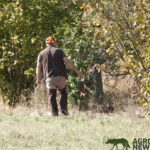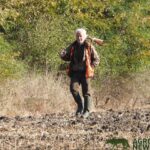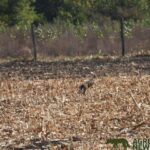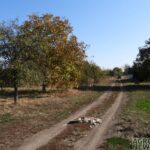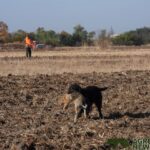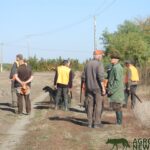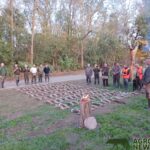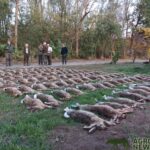Hunting
Looking Back (1938): What is golden jackal?
Gyula Éhrig wrote an article about the golden jackal in 1938
Lajos Méhely’s excellent article about the reed wolf was published forty years ago, in 1898, in the »first year of Nature. »In the case of the reed wolf, writes Méhely, we are in the darkest state of ignorance. We don’t know if we can see a definite subspecies of the wolf or just a difference in color, and we can’t even know if the jackal is hiding underneath?! “Since then, there has been no receipt for the specialists to shed light on this question; every year, an article about the reed wolf was published in one or the other magazine, but the data collected in this way were by no means sufficient to lift the veil of mystery about the racial nature of our reed wolf, in fact, the many myths and legends confused our knowledge even more. Kálmán Kittenberger also kept the exciting question on the agenda in his paper, with whom eight or ten years ago we traveled a part of the country to examine suspicious wolves buried here and there. The lack of results did not discourage us, we continued our research relentlessly.
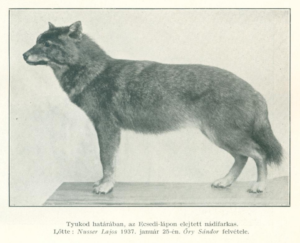
A reed wolf shoted in the border of Tyukod, on Ecsedi-bog. Shot by Lajos Nusser on January 25, 1937. Recorded by Sándor Őry. Photo: A természet
A year ago, there was a lot of excitement in the editorial office of “Nimród-Vadászújság”, I argued with Kittenberger about the letter of Lajos Nusser, the elementary school director in Tyukod, what did they shoot in Túkod, a dog or a jackal or a reed wolf? Kittenberger, no matter how enthusiastic he was about the matter, could only be distrustful based on his experience, I myself took a wait-and-see position. We wrote to director Nusser, to send the strange animal shot on the Ecsedi moor to be viewed. Days full of anticipation followed, peppered with twice-daily phone calls; we didn’t have a receipt until the package arrived. Then we were both happy, because the animal that had been shoted was indeed a jackal. At our request, Lajos Nusser donated his skin and skull to the Hungarian National Museum, and work has begun to give an accurate opinion on him.
Some were also shot in Szeremség, Valpovo; in the Nyárd forest (near Eszék, Verőce County) on November 7, 1879; Puszta-Petersliofon (near Ruma, Szerém County) on December 23, 1890; Between Zupanja and Gradiste in Lukno (Szerem County) on January 11, 1902. According to the latest data from Zagreb university professor Hirlz, the jackal lives not only on the island of Cursola and the Peljesac peninsula, but is also common everywhere in the Tustica mountains between Biograd and Zár, especially around Kotari, as well as in the coastal areas of Dalmatia and Croatia — in the Velebit. According to Calinescu’s research, the jackal also occurs in the Romanian Dobrudsa (Ghidiciu, 1929).
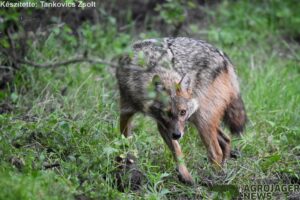
Detailed comparative studies revealed that the skull of the Tyukod jackal is the largest among the jackal skulls known so far. If this animal had only weighed more than the other jackals, we could only have said that it was well fed. However, his body weight — 13 kilos — did not exceed the average weight of the jackal, but his skull was still different from the others; this indicates that we are dealing with a new subspecies, which has developed in our country, in the favorable habitat of the once endless reeds of the Great Plain, over centuries and millennia. I named our animal Canis aureus hungaricus. I could not use the name Brusina-élé (Canis aureus balcanicus) because he applied this name to Croatian and Hungarian jackals without a description and he had not even seen a Hungarian jackal. And with this method, anyone, dividing the area of the earth on paper, you can name in advance all the unknown animals of the world to be discovered. I also had to omit the name Canis lupus minor that Mojsisovics used for the reed wolf. Not to mention that in this case I should call our cane wolf Canis aureus minor, i.e. “little jackal”, even though it is the largest among the jackals. Mojsisovich firmly believed that the reed wolf was a real wolf of small stature; also states that the jackal is often mistaken for the jackal. He also describes the jackal based on an incomplete skin, which could be a jackal based on the description, but what it was like, small or large, cannot be determined from the description. So Mojsisovics also just gave a name to an as yet unknown animal. It was reasonable to think that the Hungarian jackal was the same as the reed wolf. When I first expressed this thought, someone in the »Nimród-Vadászujság« said that the Hungarian animal divers should give grace to the memory of the cane wolves, which have merged with the memories of the old Hungarian wildernesses and were also sung by János Arany. But is it a crime if it turns out that the reed wolf was a jackal trained for the Hungarian steppes? Hardly! I am well aware that since János Arany wrote his »Toldi«, every single word of it has become a part of our Hungarianness. János Fadrusz also did not want to be disrespectful when he modeled his excellent statue, Toldi fighting with reed wolves, even though he depicted the reed wolf – very correctly – as the size of a fox rather than a wolf. that the reed wolf was a jackal trained for the Hungarian steppes? Hardly! I am well aware that since János Arany wrote his »Toldi«, every single word of it has become a part of our Hungarianness. János Fadrusz also did not want to be disrespectful when he modeled his excellent statue, Toldi fighting with reed wolves, even though he depicted the reed wolf – very correctly – as the size of a fox rather than a wolf. that the reed wolf was a jackal trained for the Hungarian steppes? Hardly! I am well aware that since János Arany wrote his »Toldi«, every single word of it has become a part of our Hungarianness. János Fadrusz also did not want to be disrespectful when he modeled his excellent statue, Toldi fighting with reed wolves, even though he depicted the reed wolf – very correctly – as the size of a fox rather than a wolf.
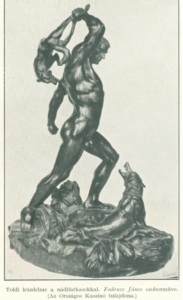
Toldi’s fight with the reed wolves. Sculpture by János Fadrusz. (Property of the National Casino.). Photo: A természet
In the old literary data, it appears that in János Arany’s well source, in Péter Ilosvai Selymes’s »Toldi«, there is no mention of a wolf at all, and even less of a reed wolf. It follows from this that at the time of the creation of the poetic work, the people still knew the reed wolf, but until now we did not know what he called it. The reed wolf was first mentioned by Kramer GH in 1756 in his work Elenchus Vegetabilium et Animalium per Austriam inferiorem observatorumc, where he says the following about the wolf: »It lives in larger forests, in reed beds, especially around Lake Nezsideri (Lake Fertő!). Since the hunters observed two versions, the one between the reeds – although its body is smaller and grayer, but still wilder – was called the reed wolf. It mainly feeds on meat.« Among our domestic writers, János Grossinger Ker. in the first volume of the »Universa História Physica Regni Hungáriaét. »The pack of wolves is evident in Hungary due to the damage caused to cattle and the numerous wolf skins.

Every winter they show themselves in groups, there are individuals or pairs that wander. The people have established two kinds among us, those who live in dense forests and those who live alone in the reeds of swamps; they are somewhat smaller and less wild than the ones in the forest, which is why they got the local name »reed wolf« from the reeds. They inhabit the islands of the Danube, Drava and Sava and the fields (plains) of the kingdom. The larger ones live scattered in the forests; most of them hide towards Dacia, in the forests of the Limestone Mountains and the Copper Forest, although the Olachians often capture wolf cubs. The old and very wild wolves are called “bearded wolves” by the people of Tiszántúl, because of the wild judgment, as if evil people turn into wolves or dogs.* Two years later, in 1795, in his book “The History of Nature”, István Gáti write about the wolf but he does not mention the jackal. In his book »Natural History« (1801), János Földi already mentions something more interesting about the wolf, because he also mentions bearded wolves. »’. . . Wolves attack much larger animals, wild boars and bears in droves, and eat the reeds and the earth when they are hungry.
The dead body is also dug up, and night appearances of something like this in Czinterem may have given the opportunity to talk about the Bearded Wolves.« Ferenc Pethe Kisszántói writes about the wolf very aptly in his book »Natural History and Craftsmanship* published in 1815, but he does not mention the reed wolf in his description of the wolf either. , nor does he mention the bearded wolf. What he writes about the jackal is all the more remarkable! »This is as cruel as the wolf we know, and it has the same predatory nature, it also digs up dead bodies. And as it may once have happened that it strayed from Asia towards us; it is more likely that the famous bearded wolf rumor would have arisen from this name than from the fact that the common wolf would have roamed around the Tzinterem: because why would they call it bearded in Hungarian and not devil-wolf; if, wouldn’t the name Jackal be the origin of the tale?« From the quotations we see that the name »reed wolf« appears in literature when the name »Jackal-wolf« is lost in the fog of legends, which name, according to Pethe, was originally a jackal-wolf, i.e. could mean jackal. In any case, it would be interesting to find out the original, old meaning of the bearded wolf even more precisely, because Pethe’s assumption is not perfect proof that the old Hungarians knew the jackal as the jackal wolf.
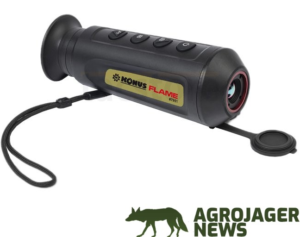
The KONUS FLAME thermal camera is simple, easy to use and also waterproof! (Photo: Agro Jager News)
In relation to this question, it is worth mentioning that János Földi describes the jackal as »Jackal or Turkish fox«. I would be willing to assume that the name jackal came to our country during the Turkish rule, that is, it is of Turkish origin; but I could not prove this, because I could find no record of the origin of the word jackal. In the third year of »Vádász és Versenylap« (1859) Sándor Havas writes the following about the wolf: »The German writers, especially the older ones, have two sexes of the wolf, forest or mountain wolf (Wald-Wolf) and meadow wolf (Sumpf oder Rohr- Wolf) distinguishes k ; we also have two types of names for this, although scientifically there is no difference between the two. Not even from a hunting point of view, anyone who has hunted wolves in Szabolcs can confirm that.
Here it would be very difficult, in fact, it would be impossible to distinguish a meadow wolf from a forest wolf, because as soon as the forest is driven, it disappears into the nearby reeds, but as soon as the rumble of hunters, hounds or greyhounds disturbs it from the dry or frozen reed thicket, it immediately takes its way to the forest or thickets . And so that during the rotation, when the bitch gathers the slovenly suitors around her with her prolonged, unpleasant pull every night, the two supposedly different species do not mix, especially here, where the meadow and the forest are so close to each other, the wolf, by his canine nature, cannot do anything up. It is also not true that the prairie tail is smaller, lower and thinner than the mountain or forest one; — I saw it a couple of years ago in Karcag, near which there is no forest for 12 square meters,
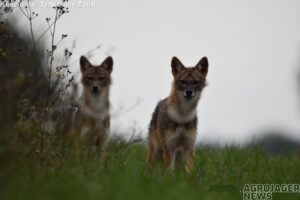
Contrary to the claims of some experts, who make too much of the differences in everything, and the wolf, as I said, is known only after the description of others, I found that the meadow wolf of the Great Plains, which breeds sheep, steers, steers, foals, horses, oxen, pigs it gets plenty, it grows almost stronger than the forest or mountain ones, which do not have such a rich selection in the end. In my opinion, the abundance or paucity of food is the only factor in the wolf that presupposes the external development of the game. It is said that the so-called meadow wolf tends to have a paler color than the one that always hangs in forests and meadows, but this can only be attributed to the influence of the sun, because the meadow does not provide such perfection and shade as the forest, and it is not even protected against rain. protecting game, his fur immediately turns pale, while the inhabitant of the forests in the cold prefers to keep its brownish, ashy color mixed here and there with mottled.* This observation about real wolves (Canis lupus) is very notable because Sándor Havas knew half a century earlier the basic rule of taxonomy and zoogeography that an animal species has the same two different subspecies cannot live in the area at the same time. Although he does not state this rule, he sees its essence with a keen eye and correctly reasons it.
Today, based on this rule, we can definitely state that the noticeably smaller reed wolf could not have been a lowland version or subspecies of the common wolf, but just another wolf-like animal. The hunting dictionary of the 3rd volume of »Vádász és Versenylap« also says: »There are two types of tails: mountain and reed. The latter is smaller and more cowardly than the first. In different landscapes: worm, roundworm or roundworm, scurvy, meadow dog; jokingly: forest-eared.« Based on the old literary data, we can only say that the reed wolf was undoubtedly smaller than the common wolf; the other notable result is that the Hungarian transformed the foreign-sounding word jackal, jackal wolf, into bearded wolf, which later he did not know what to do with, so it became an imaginary monster, which is slowly disappearing into the mists of folklore. We had to search for other defining data in order to determine what the reed tail might have been; I managed to find two pieces of data from which it can be determined without a doubt that it was racial. One of them is data on the size, or rather the weight, of the jackal. In a letter dated January 28, 1932, Károly Borovszky wrote the following: »In the 1900s, the reed tail was very common in the area of the Jamina and Morovici forest managements belonging to the Vinkovce forest office. Róbert Bokor, a relative of the former forester there, and I talked a lot about reed wolves. He never mentioned they were rare. He classified them as common, as there were quite a lot of them, at least at that time, in the reeds and forests along the Sava. from which its racial nature can be determined without a doubt. The z is one of the data relating to the size, or rather the weight, of the jackal. In a letter dated January 28, 1932, Károly Borovszky wrote the following: »In the 1900s, the reed tail was very common in the area of the Jamina and Morovici forest managements belonging to the Vinkovce forest office. Róbert Bokor, a relative of the former forester there, and I talked a lot about reed wolves. He never mentioned they were rare. He classified them as common, as there were quite a lot of them, at least at that time, in the reeds and forests along the Sava. from which its racial nature can be determined without a doubt. The z is one of the data relating to the size, or rather the weight, of the jackal. In a letter dated January 28, 1932, Károly Borovszky wrote the following: »In the 1900s, the reed tail was very common in the area of the Jamina and Morovici forest managements belonging to the Vinkovce forest office. Róbert Bokor, a relative of the former forester there, and I talked a lot about reed wolves. He never mentioned they were rare. He classified them as common, as there were quite a lot of them, at least at that time, in the reeds and forests along the Sava. »In the 1900s, the reed tail was very common in the territory of the Jamina and Morovici forest wardens belonging to the Vinkovce forest office. Róbert Bokor, a relative of the former forester there, and I talked a lot about reed wolves. He never mentioned they were rare. He classified them as common, as there were quite a lot of them, at least at that time, in the reeds and forests along the Sava. »In the 1900s, the reed tail was very common in the territory of the Jamina and Morovici forest wardens belonging to the Vinkovce forest office. Róbert Bokor, a relative of the former forester there, and I talked a lot about reed wolves. He never mentioned they were rare. He classified them as common, as there were quite a lot of them, at least at that time, in the reeds and forests along the Sava.
On the part of forester Bokor, the weight of the cane wolves in Vinkovce was indicated as 12-25 kilograms, while the weight of the wolves in Szerem was determined to be 30-40 kilograms. . . « In 1906, I was invited to the Rezét desert in the Danube, belonging to the Kalocsa archdiocese, for deer hunting. On one occasion, I managed to shoot an animal that appeared suddenly in front of me and looked like a wolf dog; because I wounded him, I sought him. We found it in an unusable condition a few days later. It was a jackal, also with a slapped tail; it could have been at most 12-15 kilograms. It was a male.« So Borovszky and Bokor’s cane wolf weight data are almost identical to the jackal’s weight data. The “slapped tail” also suits the jackal better than the wolf. However, the most famous proof of the reed wolf’s status as a jackal is a picture depicting a reed wolf hunt in the possession of the Ötömösi Geréby family.

Golden jackal hunting in Adac, Pest county, in the middle of the last century. The rider carries the jackal tied with gauze on his arm. (The work of an unknown Italian painter, owned by the Otomosi Geréby family.). Photo: A természet
In the 1830s and 40s (the exact year is unknown), the late Geréby Pál Ötömösi organized a reed wolf hunt in Adacson, Pest County; an Italian painter friend also took part in this and immortalized the hunt in three pictures. The first of the pictures shows the beginning of the drive. In the second picture, two greyhounds are fighting with a jackal. From this, the reed tail and its species cannot be determined. The third picture is even more interesting; on this, one of the riders is carrying the jackal tied in gauze on one arm. The cane wolf’s too short tail is striking; not only is it short and shaggy, but it is also bluntly lowered, that is, like a jackal. The other thing worth noting is that you cannot easily carry a 40-50-kilogram live wolf home with one hand, even when tied up! In contrast, the jackal weighs only 10-13 kilos; an animal of this weight can already be carried with one hand.

According to our only authentic image of a reed wolf, the animal was short, blunt-tailed and light. Only one kind of wolf could live in our country, namely the jackal. It follows that the Hungarians knew the jackal as the reed wolf. The cane wolf escaped the attention of experts for a long time. But why? For those who knew him esteemed him nothing because of his rough quiver; if he dropped it, he left it where he shot it. Those who did not what is it thought that it is stray dog; it is not customary to brag about dogs that have been shot to death, nor is it customary to take them home today. By the time we realized what the reed wolf could be, we could say: it was, it is not, the spreading public culture swept it away along with the reeds of the Great Plain. It’s a wonder there was even one! However, I strongly believe that where there was one, there will be more, which is why I am asking you, fox-like, white-throated, short, shaggy, with a down-tail,
Written by: Dr. Gyula Éhik – A természet March 1938, vol. 34. No. 3 59-63.
Source of photos: nature photographer Zsolt Tankovics
***
The entire content of the article (text and image) can be used by anyone with a hyperlink to the link and the same title, even without prior permission.
Do you want to advertise? Apply here: marketing@agrojager.hu
Hunting
Vadászat fényképezőgéppel: Retkes Tamás Gemencből jelentkezett – GALÉRIA
 Nagyon vágytam már az erdőbe, mert utoljára szeptember közepén jártam kint. Azóta folyamatosan vadásztak, így nem tudtam fényképezni. Most, 23-án, végre sikerült összehozni és nagyon jó mozgás volt. Reggel, már napkelte előtt kimentem, hogy az első fényeknél fényképezzek. Az egyik nyiladékon, a távolban, egy spíszer bikát vettem észre, majd egy tehenet és borját pillantottam meg, ahogy átváltanak előttem.
Nagyon vágytam már az erdőbe, mert utoljára szeptember közepén jártam kint. Azóta folyamatosan vadásztak, így nem tudtam fényképezni. Most, 23-án, végre sikerült összehozni és nagyon jó mozgás volt. Reggel, már napkelte előtt kimentem, hogy az első fényeknél fényképezzek. Az egyik nyiladékon, a távolban, egy spíszer bikát vettem észre, majd egy tehenet és borját pillantottam meg, ahogy átváltanak előttem.
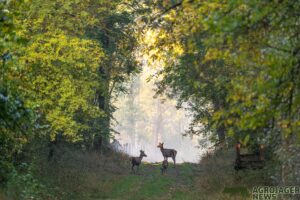
Aztán, ahogy fotóztam őket, egyszer csak egy vörös róka jött be a látómezőmbe. Gyorsan ráfókuszáltam, hogy az előtérben a rókát lássuk, miközben a háttérben a szarvasok figyelnek.
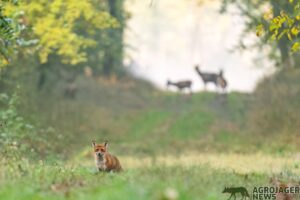
Sikerült is jó pár fotó, ahogy közeledik felém a róka. Aztán egyszer csak a bal oldalról még egy szarvasbika váltott ki, a háttérben álló a szarvasokkal. Ekkor visszaálltam a szarvasokra és készítettem megint pár fotót.
Mikor továbbindultam, nagyon jó fények fogadtak és gyönyörű volt az őszi erdő, állatok nélkül is. Így készítettem pár ilyen fotót is.
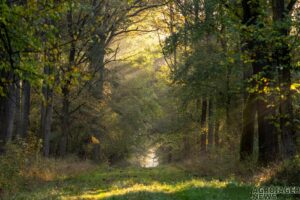
Egy másik nyiladékon, jobb oldalról, fiatal bikák, spíszerek és tarvadak borjaikkal váltottak újra ki és legeltek előttem, ahol megint csak több fotót sikerült lőnöm róluk. Innen továbbsurrantam és megint egy szép erdőrészletet örökítettem meg , majd arra lettem figyelmes, hogy több pókháló csillog a reggeli fényben. Így egy kicsit megálltam ezeket is fotózni.
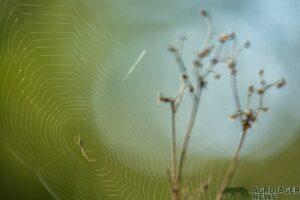
Már kifelé vettem az irányt, mikor egy nagyobb tisztáson, a nagy fűben, egy róka vöröslött már messziről. Gyorsan közelebb cserkeltem és lőttem pár fotót, ahogy éppen a reggelijét kereste. Persze, vadászott. Ezek után még egy szürkegémet, hattyúkat és egy kárókatonát örökítettem meg.
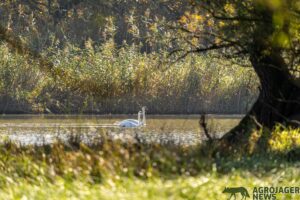
Végül dél körül értem ki az erdőből. Visszaindultam az autómhoz és örültem, hogy ennyi mindent sikerült fotóznom.
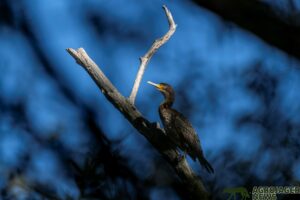
Jól esett a 18 000 lépésszám körüli séta, a cserkelés is, hogy friss levegőn lehettem, messze az emberektől, kiszakadva a város nyüzsgésétől. Így ez a hét, kedden úgy indulhatott, hogy feltöltődve tudtam munkába állni!
Írta és fényképezte:
Retkes Tamás természetfotós
Hunting
Nagyterítékű nyúlvadászat Komádiban – GALÉRIÁVAL
Komádiban, a Bihar-Népe Vadásztársaságnál jártunk, ahol francia vendégek vadásztak mezei nyúlra.
A Bihari-síkon járunk. Éppen csak átlépjük Komádinál a Sebes-Köröst s magunk mögött hagyva a Kis-Sárrét innenső felét, egészen Berettyóújfaluig, a Berettyó-folyóig nyúlik hazánk kistája. Újfaluból, ami persze város, azután vissza Nagyvárad alá, egészen a Bihari-hegyközig nyúlik, miközben nyugaton, a két folyó találkozásánál ér véget. Így tartozik egybe e táj, – benne emberrel és vaddal – elválaszthatatlanul. S hogy mit hoz a holnap, azt csak a Jóisten és az idő tudja. A református Tiszántúlon még nem távolodott el se Istentől, se a tájtól az ember, s a régi törvény még elevenen él. Hajnalodik és gyülekeznek a vadászok Komádiban, a Bihar-Népe Vadásztársaság Teleki vadászházában. Ahogyan a régi elnök szokta mondani: A vadászházba, csak odafelé lehet sietni!
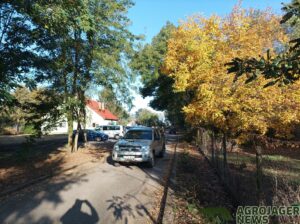
Indulás a Bihar-Népe Vadásztársaság Teleki vadászházából.
A Bihar népe vadásztársaság, Komádiban, mintegy 16 000 hektáron gazdálkodik. Egyik ékköve a Sebes-Körös, ami mintegy 14 kilométer hosszan határolja, míg másik oldalt ősgyepek nyújtózkodnak. Köztük, ha meg is ritkultak az egykori szikes mocsarak, Furtának és Vekerdnek még ma akad egy-kettő. A kistájon persze morotvaroncsok, régi, lefűződött vagy ember miatt kialakult régi folyómedrek s még dűnesorok is megtalálhatók. A táj, hogy a vizet levitték róla, ma már egyre szárazabb s a hatalmas síkság hazája lett a túzoknak, a vadlibának és persze a mezei nyúlnak. A liba nem költ a pusztában, hacsak nem veszi be magát a Körmösd-pusztai-tározó 100 hektáros vadvizeibe, de inkább a Begécsi-halastavakról, meg a szomszédból, az Emlékről, Zöldhalmiról, meg a Gazdák-taváról húz át, de akkor már itt vannak az északiak is. Hamarosan a vadlibától lesz hangos a határ – annak van most itt az ideje.
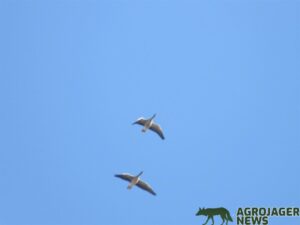
A csillagok alatt jár a vadliba!
Ami jó a túzoknak, az jó az apróvadnak és fordítva is igaz. Az intenzív dúvadgyérítés, hogy nyomában voltak a rókának, a borznak, minden földön fészkelő madárnak, emlősnek jót tett. A társaságok munkái összeérnek és mindig van egy-egy jó szomszéd, akivel, ha úgy hozza a sor, jó leülni vagy együtt menni vadászni. Az itteni ember egyáltalán nem haragtartó, de nem is felejt. Inkább ez a jellemző rá s ha meg is békél valamelyest, sokáig visszajár az emlékezet. Az adott szónak, a becsületnek súlya van és nem attól valaki, valaki, hogy kenetteljes, hanem attól, amit a Jóistennel közösen végez. Ez formálja azzá ezt a tiszántúli népet, amelynek a gyökerét mai világunkban aligha leljük meg, hiszen azok valahol, mélyen a múltból fakadnak.
Csapdából azonban lehetne több is. Beszélik, hogy a Duna-Ipoly Nemzeti Park egyik területén egy vadásztársaság használatra, majdcsak 30 csapdát is kapott, hogy üzemeltesse, hogy legyen túzok. Azt mi is felállítanánk – veti közbe Varga Balázs vadászmester, a társaság Teleki vadászházában, csak vegye meg a Hortobágyi Nemzeti Park, majd mi is kitesszük! Mindenki bólogat, mert jó volna ennek azért utánanézni és az azért nagy szó, ha igaz. Mert sokba kerül annyi csapda és no, nem lenne ennek itt ellenzője senki.
Ami igaz, az igaz. A 400-as mezei nyúl kvótát ebben az évben megemelték 1000 darabra. Tavasszal 2000-es állománnyal fordultunk rá erre az esztendőre – folytatja. Március közepén már láttunk kisnyulat, ami iszkolt a dűlőben, ami azt jelenti, hogy február végén fialhattak legelőbb.
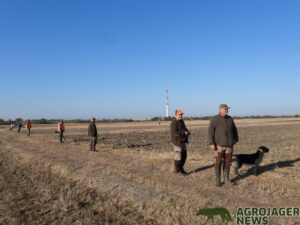
Varga Balázs jobb szélen: hajtás indul!
A vadászházban már mindenki megérkezett. Komádiban sok kutyát tartanak és szokás, hogy a kutyát errefelé nem kötik meg, annak a gazdája meg a többi vadász közt van a helye, s szabadon van mind. Ez a szokás, ez a törvény s ha „valamék” acsarkodna, azt nemcsak a gazdája fegyelmezheti. Persze hamar rend is van ilyen helyen s a kutya olyan, mint a gyerek: igen gyorsan megtanulja, mit lehet és mit nem. De nincs is ebből gond. Egyik kutya a vadászkürtre néz sandán, a másik a gazdája körül fitet, a harmadik meg jelöli már a vadásztárs csizmáját. Itt Biharban így gyülekeznek, így kezdődik a nap.
- Menjél iratkozzál már be! Úgy csinálsz, mintha nem tudnád! Na! – mordul meg Varga Balázs vadászmester, de mindenki tudja, hogy csak ilyen a szavajárása és egyébként meg sokat nem igen beszél. A fiatalok köré gyűlnek. Látható, hogy szeretik.
Az elnökkel beszélgetnek most ők ketten, Puskás Sándorral. Nem, nem vonulnak félre, ott mindenki előtt megbeszélik. Nem titkolóznak. Ha meg kell majd valami komolyabb dolgot beszélni, akkor össze ül az IB. Itt meg nem illik, nem is szokás, hogy félre vonulunk, suttogunk.
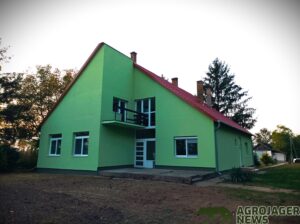
Hajnal Komádiban, a Bihar-Népe Vadásztársaság Teleki vadászházában.
Aztán valaki szól:
- Megérkeztek!
Mindenki felsorakozik és érkeznek a vendégek. Ők azok, mondja az elnöknek Balázs és a három éve visszajáró csapat körbemegy és mindenki köszön, még a legfiatalabb hajtónak is. Kürtszóval fogadják őket s a vadászok üdvözlése alatt a kutyák is illedelmesen ülnek, de már mindegyik a gazdája mellett. Köszöntő, eligazítás és a végén a vadászmester megjegyzi.
- Nagyon nem akarok sokat beszélni, mert hazajöttetek.
A tolmács, a kísérőjük fordít. Mire a franciák elmosolyodnak…
- Merci beaucoup! Merci! Köszönöm szépen! Köszönöm! – érkezik mindegyik vadásztól a felelet.
Na igen, a régi vendég akárhogy is van, hazajáró vendég, még akkor is, ha itt húzódik a trianoni határ. De mit ne mondjak? Deák Ferenc nevelt lánya, gróf Nedeczki Ferike, Szilas-pusztára báró Nagybölönyi Bölönyihez jött férjhez, s mikor tűzték ki a világégés után a határt, a Párizsban felnőtt bárónő megvendégelte a francia katonatiszteket (földmérőket), akik voltak olyan gálánsak és a birtokot mindezek után nem vágták ketté. Sovány vigasz, de úriemberek voltak, s ha fájt is, fáj is a környéknek, hogy toronyirányt nem mehetünk be ma se Nagyszalontára vagy Nagyváradra, mégis igaz, hogy az udvariasság is határokon és korokon átívelő. 100 év után talán megnyílhatnak a régi utak. Ennek az árát nem más, mint ma is az a nép fizeti meg, akik itt élnek s nemcsak ezen az oldalt, hanem a másik oldalon éppen ugyanúgy…
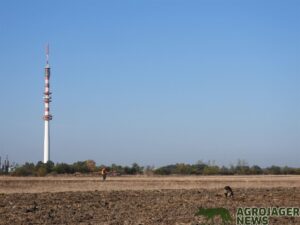
A híres Komádi TV torony: 185,5 méter magas.
S az, hogy 100 év után még beszédtéma, érthető, hiszen a határ ma is zárt s azon csak az égi vándorok, éjjel a szarvas s ki tudja, még ki ismeri a régi csapásokat, de arról hallgat a nád, hallgat a Sárrét, mert a titkok csendesek…
Ahogyan csendesek a Temető kert kerítés nélküli régi sírhantjai. Itt, ott virág díszlik, öreg fák között, régi csónakos fejfák mutatják, hogy ez itt, a Sárrét utolsó nyúlványaként, valamikor vízjárta település volt. A régi fejfák közül egy-egy megmaradt s hogy miért, azt csak az tudná megmondani, aki kivágta, aki faragta, aki a tűzben megégette a végét, hogy mit csinált véle, hogy annyi idő után egy-egy még ma is itt áll? Annak a titkát ő is magával vitte. A nagy utat jelképezték ezek a csónak alakú fejfák. Úgy gondolták, hogy itt az életben sem lehetett csónak nélkül élni s hitték, hogy odaát sem lehet anélkül megmaradni. Partosabb részeken temettek, hol másutt? Hiszen itt amerre a szem ellátott nád, nád és vízi világ volt. Komádiban temettek utoljára csónakból a Sárrétben, s volt idő, hogy Mária Teréziának teknősbékával fizették az adót.
Mindenki a fejfákat nézi, kevés szó esik. Vannak közöttünk olyanok, akik tudják, melyik fejfa alatt ki nyugszik, s merre vannak a rokonok. Régi idők öregjei nyugszanak itt, ma már nem temetünk ide – szólal meg Varga Balázs.
- Na, akkor most már álljunk fel! Persze vonalhajtás. Elálló nincs. Egy vadász, két hajtó. Menjetek! Ahogy szoktuk. Tudjátok tik!
Mikor mindenki felállt vonalban, jó vadászmesterhez illően beállt a középbe.
- Indul!
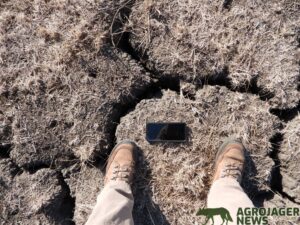
Súlyos aszály az Alföldön. Értékre vigyázni! Csak a reggeli harmat mentette meg a mezei nyulat.
A rókát nem lehet fegyverrel, csapdával és kotorékozással teljesen visszaszorítani. Ebből, ha egyet is elhagyunk, azon a területen, különösen, ha egy alomnyi kölyköt felnevel, ott nem kell apróvadra vadászni, de a túzok sem marad meg a többi madárral s ha ott elhanyagolják a dúvadazást, akkor a borz is megtelepszik. Akkor a két vadfaj elnépteleníti a mezőt.
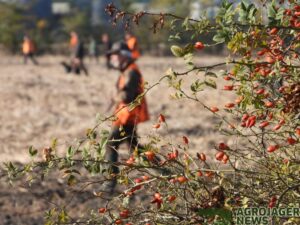
Az ősz színei a Bihari-síkon.
A tavalyi aszály és az idei rettentő nagy forróság visszaszorította a lucernásokat is, amiből egyre kevesebb van Komádiban is. A régi fajták, mint a derecskei is, ami akár 12 évig is bírta egy helyen, ma már a múlt. Egyrészt az új fajták hamar kiritkulnak, miközben az unió által előírt ciklusokat betartva, a vetésforgók miatt sem maradhat négy évnél tovább. Valamire tanítanak bennünket, mondják a gazdák, de amit itt megtanultak a szülőktől, a nagyszülőktől s azt, amit itt megfejelt, szó szerint megrámázott, megpatkolt a debreceni agrároktatás közel 170 évével, eredményessé tette a gazdákat – itt is. Amikor a gyakorlat találkozik a tudományos alapossággal kidolgozott technológiával, integrált tudással. Ezt képviseli a Debrecen Egyetem, ami ma már a középfokú intézményével, a „Balázsházyval”, egyedülálló nemcsak itt a Tiszántúlon, de a hazánkban is és szélesítve a Kárpát-medencében. 170 éves hagyománya van a felsőoktatásnak Debrecennek, ahova az itteni ember szívesen megy. Odatartozunk, hová máshová? A nagy betűs Debrecenhez és ez nem mostani hullám, ezt mondták a régi öregek is…ezt tanulta, ezt hallotta minden gyerek a szüleitől, a nagyszüleitól.
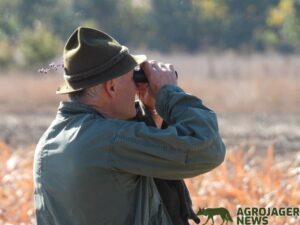
Varga Balázs vadászmester: mit látsz Kóti Dani? Elfeküdt-e?
Két hónapja nincs eső! Csoda, hogy megmaradt a nyúl s az idei augusztus végi lucernavetések, a repcevetések elmaradtak, mert rendbe tenni egy-egy földet, ilyen mérhetetlen aszályban, lehetetlenség. Persze gabona után egy azonnali tarlóhántás után megomlott a föld, de 10 centiméternél nem lehetett mélyebben művelni.
- Ki meri?! – vettette közbe valaki!
- Most ne törődjél azzal, csak szedjed a nyulat! – neveti Balázs – Vadászunk most, azt meg majd megbeszéljük odabent!
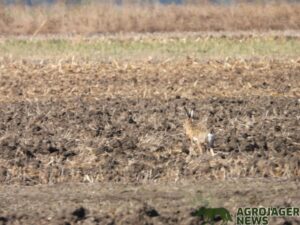
Nyúl pattan előttünk!
Mindenki tudja, mindenki látja, hogy mit terem a föld, hogy mit tud teremni s hogy mit lehet megtermelni. Nincs új a nap alatt s a távolban vetnek. Intenek, intünk. Annak kell köszönni elébb, aki érkezik. Régi törvény és ha úr, ha paraszt, akkor is így van. Az más kérdés, hogy udvariasan megállítják a gépet, hogy nyugodtan menjen csak a hajtás. Persze tudják, azok is, hogy idegenek vannak közöttünk, ne vigyék rossz hírét a városnak. Annyira nem sietnek, hova sietnének, meg aztán meg kell nézni, hogy lövik a nyulat! Kényelmesen a traktorfülkéből: az igazi, az a valódi! A vetőgépről fogadják a köszönést. A faros, most aztán nyeli a port! A nagy köszöngetés vége az lesz, hogy még a franciák is integetnek. Nincs itt baj a népekkel s ahogy szokták mondani, a vadászat összeköt, de úgy látom a mezőgazdaság is…
Szól a puska s annak ellenére, hogy nincs elálló, rengeteg a vad – dicséri a vadgazda munkáját. Ez itt a Pap tag, nyomunkban a vadaskocsival az elnök, mert sok a nyúl, nehéz vinni. Ha valaki tudja, akkor ők tudják. Az erdő akkor még nem volt meg, amikor az egyház gazdálkodott itt. Persze, a református egyház, erre abból a nyakas, rebellis fajtából való ember lakik. Szókimondó. Barátnak jó, ellenségnek veszedelmes fajta. A nagybátyám, Máté Áron Körösnagyharsányban, aki presbiter ma is, vallja, hogy az egyháznak is vissza kellett volna kapni a régi földjeit. Ott vannak azok most is, Püspök Úr – mondta a minap. Adják vissza a községnek, hogy gazdálkodhassunk rajta, mert ahogyan régen tudtak, ma is meg tudnánk művelni s akkor az eklézsia is másképpen alakulna.
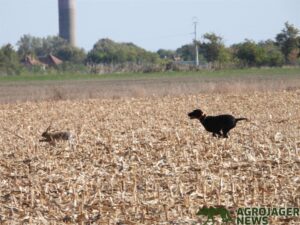
Jó kutya nélkül nem lehet vadászni!
A hite viszi előre a református embert, akkor is az vitte előre, amikor kiöntött a Körös és elvitte a falut. Az itteni ember, mondhatni az anyatejjel szívja magába ezt s ha még messze kerül is, megismérvszik róla. Persze csibész itt is van, de a betyárbecsület is létezik ám!
- Róka jár benne, vagy valami megy odabent, mert felgallyazott a fácán – szólal meg Balázs.
A tolmács fordít és mindenki a kakatoló, méltatlankodó fácánra figyel, amit persze nem látunk, csak halljuk, hogy odabent kiabál.
Fordulunk a Pap tag másik oldalára s ahogy megindulunk, újra szólnak a puskák. Elálló nélkül is ügyesek, csak hát jobban figyelni kell, mert ha ugrik a nyúl és a fegyvert nem a kezünkbe tartják, olyan előnyre tesz szert, hogy rendre lemarad a lövés, de nem a sarki, a körszakállas vadásznál. Parádés lövésekkel kedveskedik a hajtóknak és barátainak s ha úgy jön ki a sor, akad, aki meglépi. Persze látja a vadászmester s mikor odaér, hogy felvegye a nyulat megkérdi.
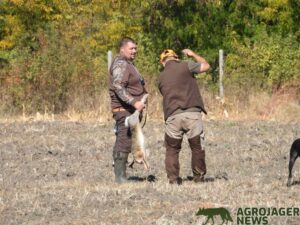
Varga Balázs vadászmester: Lődi Pistának adjatok még nyulat, bírja!
- Na, mennyi?
- 52 lépés!
- Az már valami!
Akinek nincs szerencséje, négy öt nyulat is cipel, de valaki nem igen hajol le. A hajtás végén a vadászmester mutatja, hogy mennyivel elé kapja a puskát és hogy tartsa. Sokat nem foglalkozik vele, de mikor a szőlőskertben felállunk és karikára esik az első nyúl, kalaplengetéssel üdvözli a vadászmestert!
- Merci beaucoup! Merci!
- Még a végén francia nyelvvizsgát teszünk!
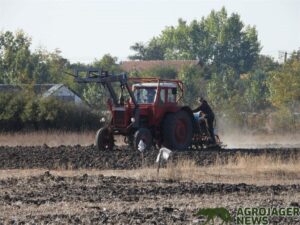
Őszit porba, tavaszit sárba!
Itt vagyunk az Öregkertben, Heréskertnek is hívják. Tátott szájjal nézem, hogy csíkról, csíkra művelt szőlők, kukoricák, tök. Az ősz gazdagsága integet felénk minden parcellában. A fene ott eszi meg a kukoricát, mondja egy régi öreg, aki mellé teszi, hogy csak a mezsgyébe lehetett vetni, mert tiltották.
- Miért tiltották? – kérdi meg valaki.
- Azért fiam, mert nem odavaló! Ilyen helyt gyümölcsöt, szőlőt, zöldséget kell termelni!
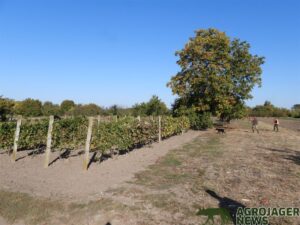
Az Öregkert Komádiban. Igazán büszkék lehetnek rá!
Egy kis kunyhóból int valaki. Balázs arra felé veszi az irányt, mert az öreg Gulyás János az. Még őt is vitte meccsekre.
- Mi voltál, szurkoló? – kérdi valaki.
- Én bal hátvéd jobb lábbal! Igaz Jancsi bácsi? – mondja a vadászmester.
- Micsoda csapat volt a Komádi Egyesület. Betyárok vótatok!
- Jaj, Jancsi bácsi, azért maga is benne volt, mert járó motorral várt bennünket!
- Kitörtetek az öltözőből, mint Zrínyi a várból!
- Mit tudtunk tenni Jancsi bácsi? Védekeztünk! A pályán meg támadtunk!
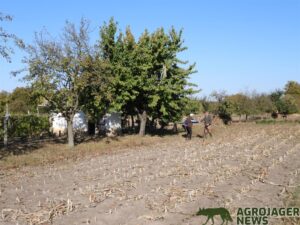
Varga Balázs Gulyás Jancsi bácsit köszönti!
Valaki még kérdezősködött, hogy mi volt, miért járt a busz, de azok ketten csak legyintettek, mert nem kell azt tudni mindenkinek. Áll a hajtás. Persze, hogy áll s a franciák is köszönnek az öreg úrnak. Aki nem idevaló is láthatja, hogy valami régi dolgokról esik szó.
- Mennünk kell Jancsi bácsi!
- Menjetek Balázs! Menjetek…
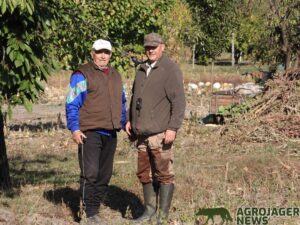
Balról Gulyás Jancsi bácsi buszvezető és Varga Balázs vadászmester, a Komádi SE régi jobb lábas bal hátvédje.
Puskás Sándor, az elnök még tudja, hol voltak a földjeik. A régi körte, amit már gyerekkorában is ismert, most is terem. Csak bicskával lehet megenni, mert akkor jó, ha az idő meghűl, mert akkor érik meg. Az íze kedvéért meg lehet kóstolni, de bakóba, szatyorba nem szed és rajta kívül nem is mehet oda senki. Egy szemet, na, igen talán annyit, de itt minden földnek, szőlőnek gazdája van. Nem azért jár ki a gazda, hogy más leegye! Micsoda dolog lenne az! S a régi törvény kerítés nélkül is él!
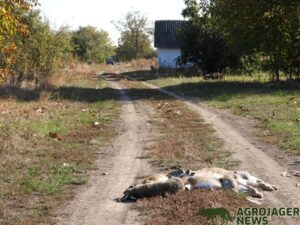
A távolban már érkezik a vadaskocsi.
A mozaikos, színes csíkok, a megannyi termesztett növény, csak kedvez az apróvadnak és szépen szól a puska. Hajolgatnak is a hajtók és az útra, ha lehet egy-egy nagyobb kupacra rakják a vadat. A szedők majd kötözik s mikor megtelik az állvány, viszik be a vadászházhoz.
- Ide még a tagi vadászaton bejövünk?
- Egyszer!
- Mert itt szépen van vad, csak azért kérdezem.
- Az lehet, de ha egyszer leberetváljuk a területet, évek kellenek mire újra lesz nyúl.
Több szó nem esik. Sora van ennek is, mint a lepényevésnek és nem lehet belenyúlni, többet vadászni. Békesség kell a vadnak és hagyni kell. Vadászni is kell, de gazdálkodásnak tudománya van.

Eb a vadász kutya nélkül! Munkában egy német vizsla a Bihar-Népe Vadásztársaság területén.
A szőlőskert csodájából a Cigány-tó dűlőnek fordulunk. Rossz, nehezen művelhető földek ezek. Mesélik nekem, hogy amikor a termelőszövetkezetbe beverték a parasztokat s azok, akik erőnek erejével nem mentek, azoknak végül itt adtak földet. A legrongyabb földek voltak azok. A tagosítás, a szocializmus építése így ment. Ma már nem, de amikor gyerek voltam, akkor még azt is beszélték, hogy Körösnagyharsányba két hétig jártak, hogy megalakítsák a termelőszövetkezetet – de hozzátették, hogy mindig csak éjjel érkeztek. S ha nem is az utcán, de egymás között megbeszélték, hogy egyedül nem mertek azok közül bejönni a házakhoz egy se. Így ment s ha el is telt lassan 70 év, látható, hogy megemlékeznek róla a vadászok, az emberek. Gyanítom, hogy egyik-másiknak, akiknek itt adtak földet, volt közötte rokona is, de ki meri megkérdezni? Nyilvánvaló azért mondja, mert a nyomorúságot nem felejti könnyen az ember. Különösen az itteni, de akkor sem törik meg.
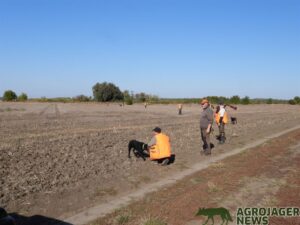
Irány a Cigány dűlő!
Na, alig lett vége a Cigány-dűlőben a hajtásnak, amikor a kisvédgát napsütötte oldalán heveredünk le. Tanakodunk, hogy merre menjen a hajtás. Én csak hallgatok, aztán úgy döntenek, hogy hajtsuk meg az erdőt. Az akácosban nem tudunk menni, de a tölgyes jó lesz. Az elnök hátrahagyja az autóját s mivel a lánya iskolában van, a kutyáját a vadászból jövet felveszi, hogy szokja a vadászat ízét, de el nem engedi.
- Tudjátok, hogy csak a lányra hallgat! – mondja.
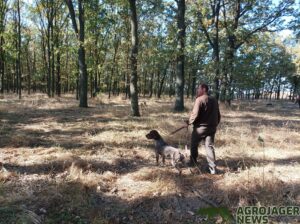
Puskás Sándor a lánya kutyáját szoktatta.
Persze tudja mindenki, de valamit mondani kell, na. Az elnököt jól ismerik és a lányát is, aki kicsi kora óta jár az apjával. Csak furcsa látvány az elnök, puska nélkül, meg egy fiatal vizslával pórázon. Balázs csak nem bírja, megszólal:
- Minek az elnöknek puska, elég, ha neve Puskás!
Jóban vannak, szoktak egymással viccelődni, meg na, tényleg szokatlan látvány is, de nagyon szereti a lányt is, a kutyát is, a vadászatot is. A kutya, ha lányé is, csak neki dolgozik az is, de nevetik, persze, hogy nevetik…
FRANCHI: hét év garanciával! A boltot a fényképre kattintva lehet elérni!
Az erdőben azonban nehezebb a dolga a vadászoknak, mert fa is van, de látható, hogy otthonosan mozognak itt is. Jól forgatják a puskát és a kutyákra is vigyáznak, ahogyan a hajtókra is. Szólni nem kellett senkire és rágyújt egy cigarettára a hajtás végén. Óvatosan szívja, mert olyan száraz a határ, mint a pozdorja lemez – kár lenne felgyújtani. Tenyérnyi repedések mindenfelé s most mondja Lődi Pista, hogy egy helyen elejtette a nyáron a telefonját és haza kellett menni ásóért, mert nem érte el…
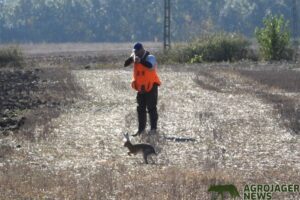
Célon. Nyúlvadászat Komádiban!
A Komádi határban nem lehet eltévedni csak ködben, mert Magyarország egyik legnagyobb tornya itt magasodik.185,5 méter, de állítólag van, akinek így is sikerül. Akiről beszélnek, nem ismerem, de ennyi elég volt, hogy mindenféle történettel színesítsék a napot.
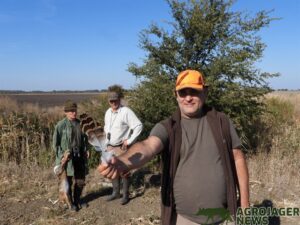
Madarat tolláról! Ez bizony túzok, mutatja Attila!
Amúgy most innen is látszik a Cigány-tóból, de látszik a református templom tornya is, a tornya olyan, mint a hódmezővásárhelyié, ez is körbe korlátos. A község újkorát 1605-től eredeztetik. A templomot 1843-ban építtették s ami igaz, az igaz, Bocskai szabad hajdúi laknak itt is. Csak megjegyzem, hogy három harang lakik a toronyban, amelyek közül a legnagyobb 1012 kilogramm! Több, mint egy tonna! Horthy Miklós kormányzó adományozta. Aki arra jár, minden nap délben hallhatja is, miközben nyolckor a kicsi szól. Vasárnap meg istentisztelet előtt, aztán hallhatjuk mind a hármat egyszerre.
Íme ->
- Na gyerünk Iráznak, neki a Lázár-laposnak! – adja ki Varga Balázs az utasítást.
A Lázár-laposon valamikor egy tanya állt, itt is és körbe mindenütt tanyák sorakoztak. Csak mikor jött az államosítás, mindet egytől, egyig széjjelverték, széjjelrángatták. Mentek az emberek a faluba, mentek innen gyárakba, Pestre és sokan meghaltak – nem bírták. Azt, mikor mindenét elvették az embereknek, azt nem lehetett elviselni. A lovat is sajnálja az ember, hogyne sajnálná, de még egy-egy jó kezebeli szerszámát is nehezen adja még kölcsönbe is, hát még akkor, amikor az a megélhetést jelentette…
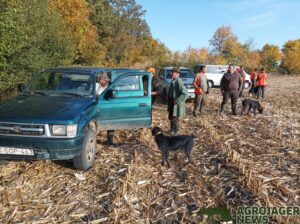
Gyülekező a Lázár-laposon.
Felsorakozunk és akárhogy is kanyargunk, akárhogy is telik az idő, akárhogy is, nap, nap után folyik a Sebes-Körös, hogy minden évben öregebb és öregebb lesz mindenki. A Lázár-tanya is már 70 éve odavan, csak, csak megállnak a vadászok és amikor ilyen helyre érkeznek, megemlékeznek róla. Már az is a Lázár-tanyáról beszél, aki nem is ismeri és szájról, szájra megtartja a vidék az emlékeit. Én se tudom, kik voltak a Tarrék, de tudom, hogy az első libáimat, az első liba dublémat, a Tarr-tanyánál lőttem apám puskájával.
Ha vadászruházat, akkor -> EWIDENT
A határban erre is, arra is megáll egy gépész. A hajtás a távolban lassan mozog. Jöttünk elébük, hogy szedjük a vadat. Ma nem, de holnap megkeresünk, abból jut majd belőle. Fog kezet az egyik emberrel a vadászmester. Feljebb egy tagtársuk bérmunkában vet, mi mást: gabonát. Ki az? A Tóth Tamás! Ilyen gépe nincs másnak!
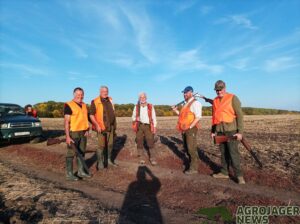
Francia vadászok a Lázár-laposon. A visszajáró vendég talán a legjobb minősítése egy vadászterületnek!
Őszit porba, tavaszit sárba! – tartja a mondás, de most, hogy két hónapja nem esik az eső, a föld is a végét járja. Arról nem is beszélve, hogy annyi pocok van, hogy napvilágon is futkosnak.
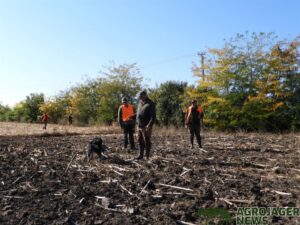
Varga Balázs vadászmester bemutatja a vendégeknek és a fiatal vadászoknak, hogyan kell egy kutyának dolgozni! Gratulálunk!
Szépen szól a puska és hajlonganak a hajtók. A kutyák is nyugodtabbak már, majd belejönnek – neveti a vadászmester, aki már látott egy-két idénykezdetet. Legalább van harmat reggel, az meg elég a nyúlnak, aztán majd megjönnek az esők és csak, csak kizöldül majd a határ.
A hajtásból egy-egy őz is kitör, az agancs még rajtuk van. Az a bak még marad, talán jövőre is, majd látjuk. Messze van még a felrakás, előttünk van a tél, de nem annak van most a sora. Elébb a nyúl, a fácán s ha úgy hozza az idő, akkor liba is lesz, meg talán kacsa is…néz a távolba Varga Balázs. Esteledik már s a távolba nézve megszólal: Még kölyök voltam, az első kutyám egy német vizsla volt és egy tacskó. Azt hittem, minden kutya ilyen, persze aztán rá kellett jöjjek, hogy ahogy minden év más, úgy sose lett nekem két olyan kutyám. Jó kutyáim voltak az biztos, de az a kettő, olyan sose lett többet. Ma is hiányoznak. A tacskó különösen, mert úgy ment a kacsa után a Sebes-Körösbe, hogy azt filmezni kellett volna, de hol volt nekünk akkor ilyen technikánk. Telefon! Benne fényképező! A vizes kiskutya a zubbonyból leste az eget, aztán akkor ugrott ki, mikor esett le a kacsa, de a vizslám is ilyen volt! Utána engedtem a lágylövött fácánnak és szaladt alatta. Ma sem tudom, hogy látta vagy hallotta? De az biztos, hogy mikor leesett, el kezdett körökbe járni, addig, míg fel nem vette a szagot… De egyszer csak körbenéz és nem folytatja…
- Mindenki kiért? Akkor rakjátok fel a vadat. Irány a vadászház!
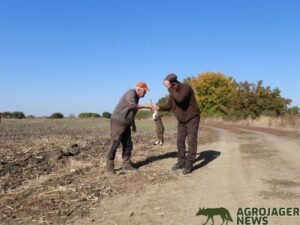
Elnöki ügy. Komádiban a társaság korábbi és jelenleg elnöke is dolgozott.
Az irázi oldalból, ami valójában Újiráz lenne, át kell menni a Homroki oldalra, ami meg teljes nevén Magyarhomorog, de azt itt nem úgy szoktuk mondani, mert rögtön tudjuk, ha valaki nem idevalósi. Komádiban két tó is várja a horgászokat, az egyik Zsadánynak, a régi nagy vásártér után hullámzik, míg a másik a Komádi Horgász Egyesületé. Míg Zsadányban az SZM Bisztró, addig itt a város közepén, a Róna Étterem várja a vendégeket. Bizton mondhatom, aki erre jár üljön be és kérdezze meg a pincéreket, hogy mit ajánl a főszakács. Elhiheti nekem, ha valaki eljön ideáig, annak a legjobbat fogják szervírozni! Ha valaki nem is tudná, hogy mi, merre van Komádiban, az csak menjen át szemközt a Húsboltba, Ica néniékhez vagy ha horgászfelszerelését elvitték a Sebes-Körös óriás harcsái, ott, a buszmegálló mellett is mindenben fognak segíteni. Csak álljunk meg és kérjünk segítséget, mintha Londonban járnánk – mindenki segíteni fog, az biztos.
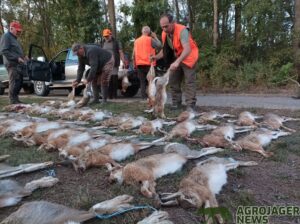
Odabent már készítik a terítéket!
S persze, aki vadászni szeretne Komádiban, a Bihar-Népe Vadásztársaságnál, az csak hívja fel Varga Balázs vadászmestert, a +36 30 495 20 79-es telefonszámon. A szállás miatt ne főjön senkinek se a feje, mert a vadászházat felújították és igen jó vendégházat lehet találni Magyarhomorogon is – igen Homrokon. A vadászházban három szoba, összesen nyolc vendéget fogad, de kicsit figyeljünk csak! Mert megszólalt a vadászkürt, ropognak a tüzek, kint a régi Kis-Sárrét utolsó maradványában, lent a Bihari-síkon, kint a Bihar-Népe Vadásztársaság Teleki vadászházának udvarán…
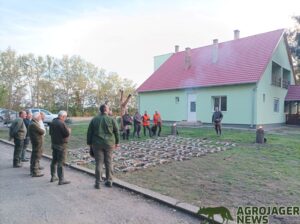
Teríték Komádiban, a Bihar-Népe Vadásztársaság Teleki vadászházában.
Írta és fényképezte:
Dr. Szilágyi Bay Péter LL.M.
Lapigazgató

- Mass Image Compressor Compressed this image. https://sourceforge.net/projects/icompress/ with Quality:80
- Mass Image Compressor Compressed this image. https://sourceforge.net/projects/icompress/ with Quality:80
- Mass Image Compressor Compressed this image. https://sourceforge.net/projects/icompress/ with Quality:80
- Mass Image Compressor Compressed this image. https://sourceforge.net/projects/icompress/ with Quality:80
- Mass Image Compressor Compressed this image. https://sourceforge.net/projects/icompress/ with Quality:80
- Mass Image Compressor Compressed this image. https://sourceforge.net/projects/icompress/ with Quality:80
- Mass Image Compressor Compressed this image. https://sourceforge.net/projects/icompress/ with Quality:80
- Mass Image Compressor Compressed this image. https://sourceforge.net/projects/icompress/ with Quality:80
- Mass Image Compressor Compressed this image. https://sourceforge.net/projects/icompress/ with Quality:80
- Mass Image Compressor Compressed this image. https://sourceforge.net/projects/icompress/ with Quality:80
- Mass Image Compressor Compressed this image. https://sourceforge.net/projects/icompress/ with Quality:80
- Mass Image Compressor Compressed this image. https://sourceforge.net/projects/icompress/ with Quality:80
- Mass Image Compressor Compressed this image. https://sourceforge.net/projects/icompress/ with Quality:80
- Mass Image Compressor Compressed this image. https://sourceforge.net/projects/icompress/ with Quality:80
- Mass Image Compressor Compressed this image. https://sourceforge.net/projects/icompress/ with Quality:80
- Mass Image Compressor Compressed this image. https://sourceforge.net/projects/icompress/ with Quality:80
- Mass Image Compressor Compressed this image. https://sourceforge.net/projects/icompress/ with Quality:80
- Mass Image Compressor Compressed this image. https://sourceforge.net/projects/icompress/ with Quality:80
- Mass Image Compressor Compressed this image. https://sourceforge.net/projects/icompress/ with Quality:80
- Mass Image Compressor Compressed this image. https://sourceforge.net/projects/icompress/ with Quality:80
- Mass Image Compressor Compressed this image. https://sourceforge.net/projects/icompress/ with Quality:80
- Mass Image Compressor Compressed this image. https://sourceforge.net/projects/icompress/ with Quality:80
- Mass Image Compressor Compressed this image. https://sourceforge.net/projects/icompress/ with Quality:80
- Mass Image Compressor Compressed this image. https://sourceforge.net/projects/icompress/ with Quality:80
- Mass Image Compressor Compressed this image. https://sourceforge.net/projects/icompress/ with Quality:80
- Mass Image Compressor Compressed this image. https://sourceforge.net/projects/icompress/ with Quality:80
- Mass Image Compressor Compressed this image. https://sourceforge.net/projects/icompress/ with Quality:80
- Mass Image Compressor Compressed this image. https://sourceforge.net/projects/icompress/ with Quality:80
- Mass Image Compressor Compressed this image. https://sourceforge.net/projects/icompress/ with Quality:80
- Mass Image Compressor Compressed this image. https://sourceforge.net/projects/icompress/ with Quality:80
- Mass Image Compressor Compressed this image. https://sourceforge.net/projects/icompress/ with Quality:80
- Mass Image Compressor Compressed this image. https://sourceforge.net/projects/icompress/ with Quality:80
- Mass Image Compressor Compressed this image. https://sourceforge.net/projects/icompress/ with Quality:80
- Mass Image Compressor Compressed this image. https://sourceforge.net/projects/icompress/ with Quality:80
- Mass Image Compressor Compressed this image. https://sourceforge.net/projects/icompress/ with Quality:80
- Mass Image Compressor Compressed this image. https://sourceforge.net/projects/icompress/ with Quality:80
- Mass Image Compressor Compressed this image. https://sourceforge.net/projects/icompress/ with Quality:80
- Mass Image Compressor Compressed this image. https://sourceforge.net/projects/icompress/ with Quality:80
- Mass Image Compressor Compressed this image. https://sourceforge.net/projects/icompress/ with Quality:80
- Mass Image Compressor Compressed this image. https://sourceforge.net/projects/icompress/ with Quality:80
- Mass Image Compressor Compressed this image. https://sourceforge.net/projects/icompress/ with Quality:80
- Mass Image Compressor Compressed this image. https://sourceforge.net/projects/icompress/ with Quality:80
- Mass Image Compressor Compressed this image. https://sourceforge.net/projects/icompress/ with Quality:80
- Mass Image Compressor Compressed this image. https://sourceforge.net/projects/icompress/ with Quality:80
- Mass Image Compressor Compressed this image. https://sourceforge.net/projects/icompress/ with Quality:80
- Mass Image Compressor Compressed this image. https://sourceforge.net/projects/icompress/ with Quality:80
- Mass Image Compressor Compressed this image. https://sourceforge.net/projects/icompress/ with Quality:80
- Mass Image Compressor Compressed this image. https://sourceforge.net/projects/icompress/ with Quality:80
- Mass Image Compressor Compressed this image. https://sourceforge.net/projects/icompress/ with Quality:80
- Mass Image Compressor Compressed this image. https://sourceforge.net/projects/icompress/ with Quality:80
- Mass Image Compressor Compressed this image. https://sourceforge.net/projects/icompress/ with Quality:80
- Mass Image Compressor Compressed this image. https://sourceforge.net/projects/icompress/ with Quality:80
- Mass Image Compressor Compressed this image. https://sourceforge.net/projects/icompress/ with Quality:80
- Mass Image Compressor Compressed this image. https://sourceforge.net/projects/icompress/ with Quality:80
- Mass Image Compressor Compressed this image. https://sourceforge.net/projects/icompress/ with Quality:80
- Mass Image Compressor Compressed this image. https://sourceforge.net/projects/icompress/ with Quality:80
- Mass Image Compressor Compressed this image. https://sourceforge.net/projects/icompress/ with Quality:80
- Mass Image Compressor Compressed this image. https://sourceforge.net/projects/icompress/ with Quality:80
- Mass Image Compressor Compressed this image. https://sourceforge.net/projects/icompress/ with Quality:80
- Mass Image Compressor Compressed this image. https://sourceforge.net/projects/icompress/ with Quality:80
- Mass Image Compressor Compressed this image. https://sourceforge.net/projects/icompress/ with Quality:80
- Mass Image Compressor Compressed this image. https://sourceforge.net/projects/icompress/ with Quality:80
- Mass Image Compressor Compressed this image. https://sourceforge.net/projects/icompress/ with Quality:80
- Mass Image Compressor Compressed this image. https://sourceforge.net/projects/icompress/ with Quality:80
- Mass Image Compressor Compressed this image. https://sourceforge.net/projects/icompress/ with Quality:80
- Mass Image Compressor Compressed this image. https://sourceforge.net/projects/icompress/ with Quality:80
- Mass Image Compressor Compressed this image. https://sourceforge.net/projects/icompress/ with Quality:80
- Mass Image Compressor Compressed this image. https://sourceforge.net/projects/icompress/ with Quality:80
- Mass Image Compressor Compressed this image. https://sourceforge.net/projects/icompress/ with Quality:80
- Mass Image Compressor Compressed this image. https://sourceforge.net/projects/icompress/ with Quality:80
- Mass Image Compressor Compressed this image. https://sourceforge.net/projects/icompress/ with Quality:80
- Mass Image Compressor Compressed this image. https://sourceforge.net/projects/icompress/ with Quality:80
- Mass Image Compressor Compressed this image. https://sourceforge.net/projects/icompress/ with Quality:80
- Mass Image Compressor Compressed this image. https://sourceforge.net/projects/icompress/ with Quality:80
- Mass Image Compressor Compressed this image. https://sourceforge.net/projects/icompress/ with Quality:80
- Mass Image Compressor Compressed this image. https://sourceforge.net/projects/icompress/ with Quality:80
- Mass Image Compressor Compressed this image. https://sourceforge.net/projects/icompress/ with Quality:80
- Mass Image Compressor Compressed this image. https://sourceforge.net/projects/icompress/ with Quality:80
- Mass Image Compressor Compressed this image. https://sourceforge.net/projects/icompress/ with Quality:80
- Mass Image Compressor Compressed this image. https://sourceforge.net/projects/icompress/ with Quality:80
- Mass Image Compressor Compressed this image. https://sourceforge.net/projects/icompress/ with Quality:80
- Mass Image Compressor Compressed this image. https://sourceforge.net/projects/icompress/ with Quality:80
- Mass Image Compressor Compressed this image. https://sourceforge.net/projects/icompress/ with Quality:80
- Mass Image Compressor Compressed this image. https://sourceforge.net/projects/icompress/ with Quality:80
- Mass Image Compressor Compressed this image. https://sourceforge.net/projects/icompress/ with Quality:80
- Mass Image Compressor Compressed this image. https://sourceforge.net/projects/icompress/ with Quality:80
- Mass Image Compressor Compressed this image. https://sourceforge.net/projects/icompress/ with Quality:80
- Mass Image Compressor Compressed this image. https://sourceforge.net/projects/icompress/ with Quality:80
- Mass Image Compressor Compressed this image. https://sourceforge.net/projects/icompress/ with Quality:80
- Mass Image Compressor Compressed this image. https://sourceforge.net/projects/icompress/ with Quality:80
- Mass Image Compressor Compressed this image. https://sourceforge.net/projects/icompress/ with Quality:80
- Mass Image Compressor Compressed this image. https://sourceforge.net/projects/icompress/ with Quality:80
- Mass Image Compressor Compressed this image. https://sourceforge.net/projects/icompress/ with Quality:80
- Mass Image Compressor Compressed this image. https://sourceforge.net/projects/icompress/ with Quality:80
- Mass Image Compressor Compressed this image. https://sourceforge.net/projects/icompress/ with Quality:80
- Mass Image Compressor Compressed this image. https://sourceforge.net/projects/icompress/ with Quality:80
- Mass Image Compressor Compressed this image. https://sourceforge.net/projects/icompress/ with Quality:80
- Mass Image Compressor Compressed this image. https://sourceforge.net/projects/icompress/ with Quality:80
- Mass Image Compressor Compressed this image. https://sourceforge.net/projects/icompress/ with Quality:80
- Mass Image Compressor Compressed this image. https://sourceforge.net/projects/icompress/ with Quality:80
- Mass Image Compressor Compressed this image. https://sourceforge.net/projects/icompress/ with Quality:80
- Mass Image Compressor Compressed this image. https://sourceforge.net/projects/icompress/ with Quality:80
- Mass Image Compressor Compressed this image. https://sourceforge.net/projects/icompress/ with Quality:80
- Mass Image Compressor Compressed this image. https://sourceforge.net/projects/icompress/ with Quality:80
- Mass Image Compressor Compressed this image. https://sourceforge.net/projects/icompress/ with Quality:80
- Mass Image Compressor Compressed this image. https://sourceforge.net/projects/icompress/ with Quality:80
- Mass Image Compressor Compressed this image. https://sourceforge.net/projects/icompress/ with Quality:80
- Mass Image Compressor Compressed this image. https://sourceforge.net/projects/icompress/ with Quality:80
- Mass Image Compressor Compressed this image. https://sourceforge.net/projects/icompress/ with Quality:80
- Mass Image Compressor Compressed this image. https://sourceforge.net/projects/icompress/ with Quality:80
- Mass Image Compressor Compressed this image. https://sourceforge.net/projects/icompress/ with Quality:80
- Mass Image Compressor Compressed this image. https://sourceforge.net/projects/icompress/ with Quality:80
- Mass Image Compressor Compressed this image. https://sourceforge.net/projects/icompress/ with Quality:80
- Mass Image Compressor Compressed this image. https://sourceforge.net/projects/icompress/ with Quality:80
- Mass Image Compressor Compressed this image. https://sourceforge.net/projects/icompress/ with Quality:80
- Mass Image Compressor Compressed this image. https://sourceforge.net/projects/icompress/ with Quality:80
- Mass Image Compressor Compressed this image. https://sourceforge.net/projects/icompress/ with Quality:80
- Mass Image Compressor Compressed this image. https://sourceforge.net/projects/icompress/ with Quality:80
- Mass Image Compressor Compressed this image. https://sourceforge.net/projects/icompress/ with Quality:80
- Mass Image Compressor Compressed this image. https://sourceforge.net/projects/icompress/ with Quality:80
- Mass Image Compressor Compressed this image. https://sourceforge.net/projects/icompress/ with Quality:80
- Mass Image Compressor Compressed this image. https://sourceforge.net/projects/icompress/ with Quality:80
- Mass Image Compressor Compressed this image. https://sourceforge.net/projects/icompress/ with Quality:80
- Mass Image Compressor Compressed this image. https://sourceforge.net/projects/icompress/ with Quality:80
- Mass Image Compressor Compressed this image. https://sourceforge.net/projects/icompress/ with Quality:80
- Mass Image Compressor Compressed this image. https://sourceforge.net/projects/icompress/ with Quality:80
- Mass Image Compressor Compressed this image. https://sourceforge.net/projects/icompress/ with Quality:80
- Mass Image Compressor Compressed this image. https://sourceforge.net/projects/icompress/ with Quality:80
- Mass Image Compressor Compressed this image. https://sourceforge.net/projects/icompress/ with Quality:80
- Mass Image Compressor Compressed this image. https://sourceforge.net/projects/icompress/ with Quality:80
- Mass Image Compressor Compressed this image. https://sourceforge.net/projects/icompress/ with Quality:80
- Mass Image Compressor Compressed this image. https://sourceforge.net/projects/icompress/ with Quality:80
- Mass Image Compressor Compressed this image. https://sourceforge.net/projects/icompress/ with Quality:80
- Mass Image Compressor Compressed this image. https://sourceforge.net/projects/icompress/ with Quality:80
Hunting
A wild boar was shot in Slovakia
It was a beautiful October day, it was pleasantly warm outside, so my son and I decided to go hunting. We sat down and waited if we would be allowed to see or catch something. Unfortunately, 3 hours of waiting did not bring any success. After dark we decided it was time to go.
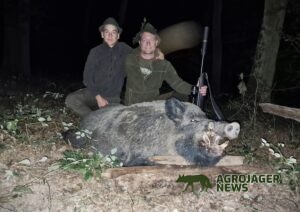
Pavel Chivan with his son and the wild boar of his life. Photo: Agro Jager News
No success today. On the way, we wondered what could be the reason that we could not see anything. We also met a colleague and so we continued together. He asked if we have time, that we could walk through the forest together, because a lot of acorns are falling and there will definitely be something there. So it was and we went through the oak forest.
FRANCHI: hét év garanciával! A boltot a fényképre kattintva lehet elérni!
And he was right, lots of deer, mouflons grazing on acorns. After a short walk, in my hand termo I noticed that something was standing behind the bushes in the forest. I turned on the thermo on my gun and saw the boar’s head. I didn’t hesitate and a shot broke the silence of the night forest.
Ha vadászruházat, akkor -> EWIDENT
Since I was shooting at a longer distance and I was not sure of a shot through the dense forest, I preferred to let my dog go ahead of me. After a while, the most beautiful sound that the owner of a hunting dog can imagine began to echo through the forest.
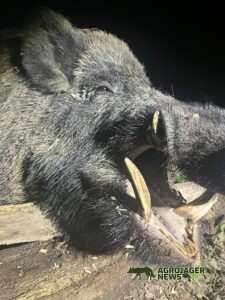
The Slovak wild boar. Photo: Agro Jager News / Pavel Chivan
Bavarian dyer’s report. We approached the caught piece and couldn’t help ourselves. God gave me probably my life’s wild boar. Weapons length 24 cm and 125 points. Thanks to my colleague Damian Gondek for convincing us to walk through the forest!
Written by Pavel Chivan




